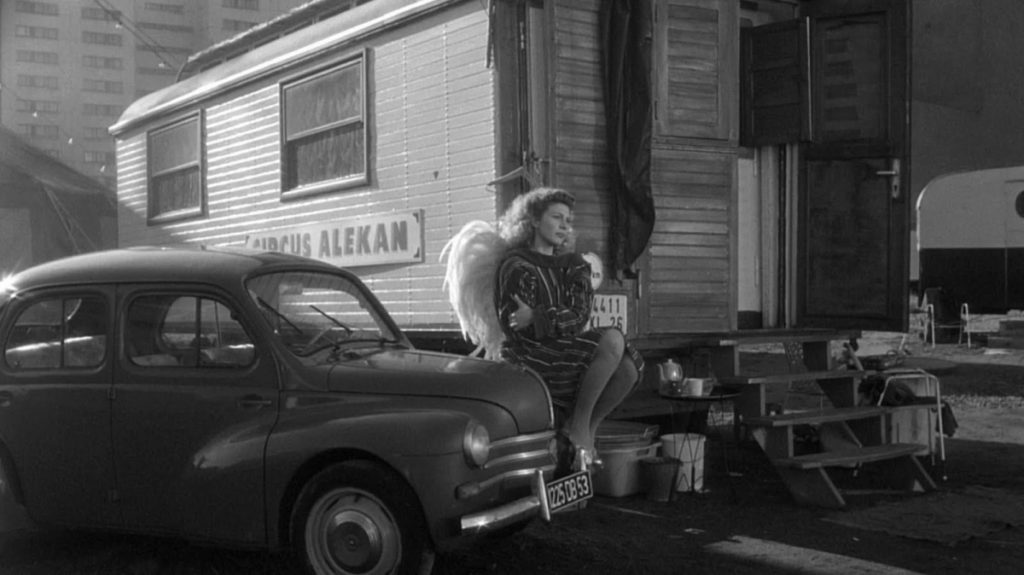
In 1987, after working in America for several years, Wim Wenders returned to West Germany, more specifically West Berlin, to make his film Wings Of Desire (1987). Wings Of Desire is, however, more than a literal coming home for the director, but a return to earlier thematic interests and collaborations. Wenders enlisted playwright and novelist Peter Handke to pen the internal monologues for Wings Of Desire, rekindling a collaboration that had begun in 1972 on the film The Goalie’s Anxiety At The Penalty Kick. Thematically, Wings Of Desire also returns to the themes of Wenders’ classic period in Germany that began with Alice In The Cities (1974), and whose primary concern, allegorical or not, was the disenfranchisement of German identity as a result of the Cold War. In Wings Of Desire these themes are transposed from a reflective reality into an ethereal reality; Romantic in a distinctly German way.
The ethereal reality of Wenders’ angels is executed to great effect with sequences shot in black and white that are juxtaposed to color sequences that represent the human reality in which the angels are never visually present. The angels themselves, Damiel (Bruno Ganz) and Cassiel (Otto Sander), avoid any overt visual connection to a recognizable theological iconography. Wenders’ angels appear plainly dressed in drab clothes, slouching in brown trench coats, appearing more like bums than like the angels of Western mythology. This humanizes the characters, making it acceptable to the audience that Damiel could be faulted and could inevitably fall in love with the acrobat Marion (Solveig Dommartin).
Yet, for all their human qualities, the world of the angels at the top of West Berlin’s high rises and monuments is a world of fantasy directly lifted from the films of Jean Cocteau. Wenders employs a number of analog visual effects, often using trick photography, to imbue the singular world of the angels with Cocteau’s unique brand of playful whimsy that effortlessly brings these scenes to life with awe and wonder. But these visual effects also allow Wenders to cut around West Berlin in feverish montage, where, for entire sequences, the camera will explore various sections of the city before revealing an angel to the audience. Wenders’ concern with location as a third type of character is derivative, not just in concept but also in presentation, of Walter Ruttmann’s epic experimental film Berlin Symphony Of A Great City (1927). In fact, the type of black and white film stock Wenders selected to shoot with combines both the aesthetics of Cocteau and Ruttmann.
Wings Of Desire does more by design then capture the physical goings on of West Berlin, but functions as an anthropological document of the culture that was popular at the time, and the traditions that continued to shape the German perspective on imported popular American culture (a defining theme that occurs throughout the New German films of the seventies). Marion herself best represents this conflict between authentically German culture and imported popular culture. Marion works as an acrobat at a seasonal circus, whose format and presentation is unique to Europe, and has remained a tradition for over four hundred years. But Marion also engages in an active nightlife, frequenting dance clubs where Nick Cave & The Bad Seeds and Crime & The City Solution perform. These groups are, in effect, imports from Great Britain and Australia touring West Germany.
Though this contrast is at its most visually dramatic in these sequences with Marion, the scenes in which Damiel and Cassiel listen in on the thoughts of Homer (Curt Bois) are the most extreme in presenting this concept, though only ever in dialogue. As his name suggests, Homer is a poet storyteller, whose accounts of West Berlin life and the myriad of transformations it has undergone since the close of WWII act as a sub plot unto itself. Handke’s monologue for Homer provides all the context, the explanation as to why things are the way they are, not politically, but in terms of the Berliner’s attitude to his/her daily life.
Wings Of Desire does not only explore the cultural diffusion of West German culture through its fictional characters, but also through the use of a real life celebrity, Peter Falk, who plays a version of himself and represents the most easily accessible signifier in the film. Like the characters that surround Peter Falk, the audience will most likely associate the actor with his role as Columbo, an American television program. And like Homer, Falk also serves a narrative purpose, himself being an angel come to earth, mentoring Damiel when he makes the same transition to be with Marion. But Falk’s internal monologue is unique in the film, representing the only non-German perspective in the film, a counterpoint to Homer. Falk, in essence, is the “ugly American” the film needs to stay afloat in terms of its analysis of life in West Berlin.
As in Cocteau’s Orpheus (1949), and perhaps in homage to it, Damiel must plunge himself into an unknown world to be with the woman he loves, Marion. This, and the sum of all of Wings Of Desire’s parts function as an encapsulation of the European film tradition, though from a distinctly German perspective. As in all of Wenders’ films, the history of cinema is at the heart of the film, and serves as the single motivator behind the technical construction of the film. Allegorically speaking, Wenders is Damiel, plunging himself into a strange world to be with what he loves, the cinema.
